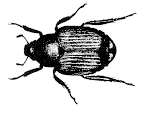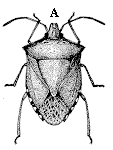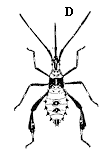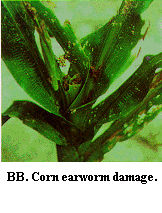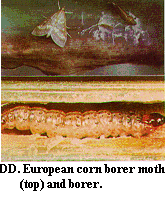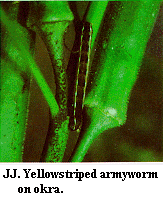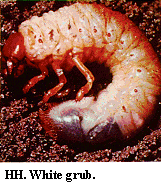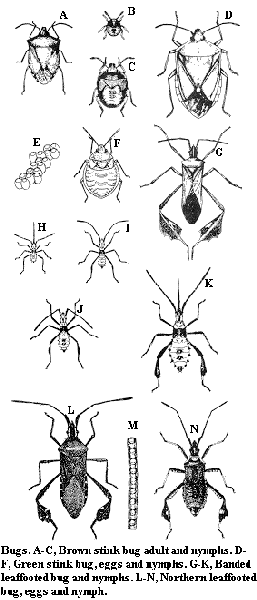Key to Okra Pests
Okra has few noticeable pests. Pods curled or with wart-like protrusions commonly indicate earlier feeding damage by stink bugs and / or leaffooted bugs. Corn earworms also infest pods occasionally. Damage to the foliage is normally unimportant, unless Japanese beetle populations are unusually high.
A. Insects that feed externally on buds, foliage, or pods
- Chewing insects that leave holes in plants
- Corn earworm – Early instar cream colored or yellowish-green with few markings; later instar green, reddish, or brown with pale longitudinal stripes and scattered black spots; moderately hairy; up to 44 mm long; three pairs of legs, five pairs of prolegs (Figure 1); eats holes in pods
- Japanese beetle – Hard-bodied, shiny, metallic green beetle with coppery brown wing covers which meet in a straight line down the center of the back; body about 13 mm long (Figure 2); skeletonizes leaves; may also eat pods
- Pests that cause discoloration or distortion of plant
- Aphids – Soft-bodied, pear-shaped insects with a pair of dark cornicles and a cauda protruding from the abdomen; may be winged or wingless - wingless forms most common; feed in colonies; excrete honeydew on which sooty mold grows.
- Green peach aphid – Pale yellow to green wingless adult up to 2.4 mm long; winged adult with dark dorsal blotch on yellowish-green abdomen; cornicles over twice as long as cauda and slightly swollen toward tip; yellow-green nymph with three dark lines on abdomen (Figure 3A-C)
- Melon aphid – Yellow or green in host, dry summers; pale to dark green in cool seasons; body up to 2 mm long; cornicles slightly longer than or twice as long as cauda; nymph similar in color to adult (Figure 4A-C)
- Leaffooted bugs and stink bugs – Bugs up to 19 mm long; adult green or brown and shield-shaped (stink bug, Figure 5A), or brown with enlarged, flattened hind legs (leaffooted bug, Figure 5B); stink bug nymph pale green or green with orange and black markings (Figure 5C); leaffooted bug nymph red (Figure 5D); pierce buds, pods, and seeds causing pods to be deformed and seeds to be shriveled; wart-like growths appear on pods
- Aphids – Soft-bodied, pear-shaped insects with a pair of dark cornicles and a cauda protruding from the abdomen; may be winged or wingless - wingless forms most common; feed in colonies; excrete honeydew on which sooty mold grows.
B. Insects that feed inside the plant, e.g., within the stalk or leaf mesophyll
- European corn borer – Pale yellow or pinkish caterpillar up to 26 mm long with several rows of tiny, darkly colored spots; three pairs of legs near the head; five pairs of prolegs (Figure 6); leaves entrance hole fringed with silk and frass in stalk; weakens stem and interferes with pod development
- Vegetable leafminer – Colorless to bright yellow maggot with black mouthparts; body up to 3 mm long; pointed head; S-shaped mines in leaves, often enlarged at one end (Figure 7)
Japanese Beetle
Japanese beetle, Popillia japonica Newman, Scarabaeidae, COLEOPTERA
DESCRIPTION
Adult – About 13 mm long, this shiny, metallic green beetle has coppery brown wing covers which extend almost to the tip of the abdomen. Two small tufts of white hairs occur just behind the wing covers on each side of the body. Five more white patches are located on each side of the abdomen.
Egg – The white or cream colored egg is spherical and about 1.5 mm in diameter when first laid in turf. By the time it hatches, the egg has doubled its original size.
Larva – The grayish-white, slightly curled grub has a yellowish-brown head and measures about 26 mm long when mature. It can be distinguished from other white grubs by two rows of spines which form a "V" on the underside of its last abdominal segment.
Pupa – The cream colored pupa, approximately 13 mm long and 6 mm wide, gradually turns light brown and finally develops a metallic green cast.
BIOLOGY
Distribution – First reported in North America in 1916, the Japanese beetle now occurs in more than 20 states from southern Maine southward into Georgia and westward into Kentucky, Illinois, Michigan, and Missouri. It occurs statewide in North Carolina with heaviest infestations in the central Piedmont and Mountain areas.
Host Plants – Adult Japanese beetles infest over 275 different plants including most vegetable crops. Shade and fruit trees, ornamental shrubs, small fruits, garden crops, weeds, and field crops often are damaged also. The grubs are serious pests of lawns, other grasses, and nursery stock.
Damage – Gregarious in nature, Japanese beetle adults are often found feeding in masses on flowers, foliage, or fruit of a few plants leaving others nearby uninfested. On most hosts, including okra, leaves are skeletonized and mature fruit is damaged. Injury to corn occurs when beetles feed heavily on the silks and ear tips, sometimes reducing pollination and predisposing the ear to other insect damage and fungal infections. In localized spots, larvae injure the developing root systems of grass crops or weeds.
Life History – The grubs overwinter in cells within 13 cm of the soil surface. In spring they move upward, almost to ground level, where they complete feeding and pupate. The three larval instars complete development in about 140 days. Adults emerge as early as mid-May in eastern North Carolina and as late as July in New England. Throughout summer they attack the fruit and foliage of many plants including silks of corn. In North Carolina, peak emergence occurs during July. Soon after emerging females deposit 40 to 60 eggs in small batches 5 to 8 cm deep in the ground. Under extremely dry conditions, many eggs and larvae perish. However, during warm, set summers populations thrive and eggs hatch about 2 weeks after deposition. Newly emerged larvae feed until cold weather forces them into hibernation. Only one generation occurs each year.
CONTROL
Milky spore disease and several parasites often attack beetle grubs and thereby keep Japanese beetle adult populations below economically damaging levels.
Control of this pest is rarely necessary on okra or on vegetable crops which are sprayed regularly for control of other insect pests. Some plants in border rows may appear heavily infested due to the tendency of these beetles to congregate. Field tests in Virginia have shown that much Japanese beetle damage to corn can be avoided by planting so that silking occurs before July 20 or after August 1. Should excessive populations develop, consult the current North Carolina Agricultural Chemicals Manual.
Stink Bugs and Leaffooted Bugs
Green stink bug, Acrosternum hilare (Say), Pentatomidae, HEMIPTERA
Brown stink bug, Euschistus servus (Say), Pentatomidae, HEMIPTERA
Leaffooted bug, Leptoglossuis phyllopus, Coreidae, HEMIPTERA
DESCRIPTION
Adult – All adult stink bugs are shield-shaped. About 14 to 19 mm long, green stink bugs are bright green with a narrow orange-yellow line bordering the major body regions. Brown stink bugs are dull grayish-yellow in color and 12 to 15 mm long. Leaffooted bugs are about 20 mm long, have dark brown bodies, a narrow cream colored stripe across the back, and flattened, leaf-like hind legs.
Egg – When first laid, the 1.4 x 1.2 mm barrel-shaped eggs of the green stink bug are yellow to green, later turning pink to gray. The white kettle-shaped eggs of the brown stink bug are slightly smaller than those of the green stink bug. Leaffooted bug eggs are slightly keg shaped.
Nymph – Nymphs of all three bugs are smaller than, yet similar in shape to the adults. Green stink bug nymphs are predominantly black when small, but as they mature, they become green with orange and black markings. Nymphs of the brown species are light green. Leaffooted bug nymphs are bright red.
BIOLOGY
Distribution – Brown and green stink bugs have been reported as far north as Quebec; however, in the United States, they are more often injurious in the South. Also more common in the South, leaffooted bugs occur as far west as Arizona.
Host Plants – Stink bugs feed on more than 52 plants, including native and ornamental trees, shrubs, vines, weeds, and many cultivated crops. The preferred hosts are nearly all wild plants. Stink bugs build up on these hosts and move to cultivated hosts as their preferred food becomes unpalatable. Among vegetable crops, stink bugs attack bean and cowpea seeds, okra pods, ripening tomato fruit, and stems of melons and asparagus. Bean, cowpea, sorghum, eggplant, potato, tomato, peach, strawberry, okra, and watermelon are only a few of the leaffooted bug's many host plants.
Damage – Nymphs and adults of both kinds of bugs pierce plants with their needle-like mouthparts and suck sap from pods, buds, blossoms, and seeds. The degree of damage depends, to some extent, on the developmental stage of the plant when it is pierced by the stink bug. Immature fruits and pods punctured by bugs become deformed as they develop. Seeds are often flattened and shriveled, and germination is reduced.
Life History – Stink bugs overwinter as adults in ditch banks, along fence rows, on roadsides, and in other similar places. They become active in spring when temperatures rise above 21°C (70°F). Each female deposits up to several hundred eggs, usually in mid- to late June. These eggs are laid in clusters, primarily on leaves and stems, but also on pods. Nymphs hatch from these eggs and pass through five instars before becoming adults. Approximately 5 weeks elapse between hatching and adult emergence. Two generations per year occur in Arkansas while only one generation per year has been reported in Virginia. In any case, stink bugs usually reach high population levels in late September or early October.
The biology of leaffooted bugs is not well documented. They overwinter as adults and have been collected all months of the year. However, they are most common from May onward into the fall months.
CONTROL
Stink bugs have some enemies, including several common species of birds. However, as their name implies, stink bugs repel many predators by giving off an offensive odor.
Thorough weed control may reduce overwintering populations near fields but infestation by stink bugs emerging from nearby woods or other areas is inevitable. The use of insecticides is the most reliable method of control. For up-to-date recommendations, consult the current North Carolina Agricultural Chemicals Manual.
Publication date: Feb. 10, 2003
AG-295
Other Publications in Insect and Related Pests of Vegetables
N.C. Cooperative Extension prohibits discrimination and harassment regardless of age, color, disability, family and marital status, gender identity, national origin, political beliefs, race, religion, sex (including pregnancy), sexual orientation and veteran status.


